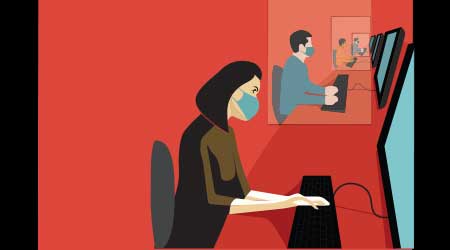Many Pandemic Facility Changes Are Here to Stay
Many have realized that changes made as a result of the pandemic can be implemented permanently as they can have long-term positive effects on the health and wellness of occupants.
With the rise of coronavirus cases following Thanksgiving, Michigan’s governor ordered all schools, including universities, to return to remote learning. Strazdas predicts that remote learning will be an area of growth, post-pandemic, since it is a cheaper route to receiving a college education.
Many experts predict that new habits developed during the pandemic will remain post-pandemic, along with enhanced health and safety measures.
“Much of what we are doing is here to stay,” says Bedborough. “The research says [coronavirus] has different forms and is developing and evolving, so we will constantly need to look at protocols, methodologies, and the products we are using to ensure they are applicable and appropriate at that point in time. We might see the back of COVID-19 with the deployment of the vaccine, but we don’t know how long the vaccine will last,” Bedborough says.
While the new vaccines look extremely promising, they do not promise 100 percent effectiveness, and for this reason, people will likely remain hypervigilant about their workspace and interaction with colleagues. Thus, current best practices will become the norm to make people safe as well as give them psychological reassurance.
Wollenzein agrees that it will fall to facility managers to “give people a good reason to want to step out of their homes” and travel every day to an office. Some items that are becoming standard in buildings are touchless door openers, soap dispensers, faucets, urinal flushers, and the like.
“If you have food service, you will get packaged food or a server will serve you your food; the day of the buffet is gone,” Wollenzein says.
Johnson says some best practices that will be retained are the “installation of MERV 13 filters or higher and the use of anti-bacterial cleaning materials in lieu of 100 percent green cleaning materials. The industry will look to make the innovations that have come out of the pandemic more cost effective and usable in building retrofits and not just in new construction installations,” he says.
Currently Northwestern Mutual is retaining only a skeleton crew on site — 300 essential workers of 6,000. “At some point a greenlight will be given to come back, but will there be a mad rush?” Wollenzein asks. He thinks initially people will be excited to come back to work but then will want to revert to working from home.
“I see [the work environment] as a blend. People may come in a day or two,” he says, but probably not five days per week. If working from home becomes more permanent, workspace may need to be reconfigured. Perhaps people will share desks, for example, and companies may need more space, not less, if they are setting up office furniture to follow social distancing guidelines.
“In some of our newer spaces we have that six-foot plus distance apart already,” Wollenzein says, but people will also want collaboration spaces. “We are going to take it one step at a time,” he says. “We are not going to reconfigure a whole building on a speculation.” Clearly, more research will be needed to answer important questions about how people will want to work.
Maryellen Lo Bosco is a freelance writer who covers facility management and technology. She is a contributing writer for Building Operating Management.
Related Topics:













